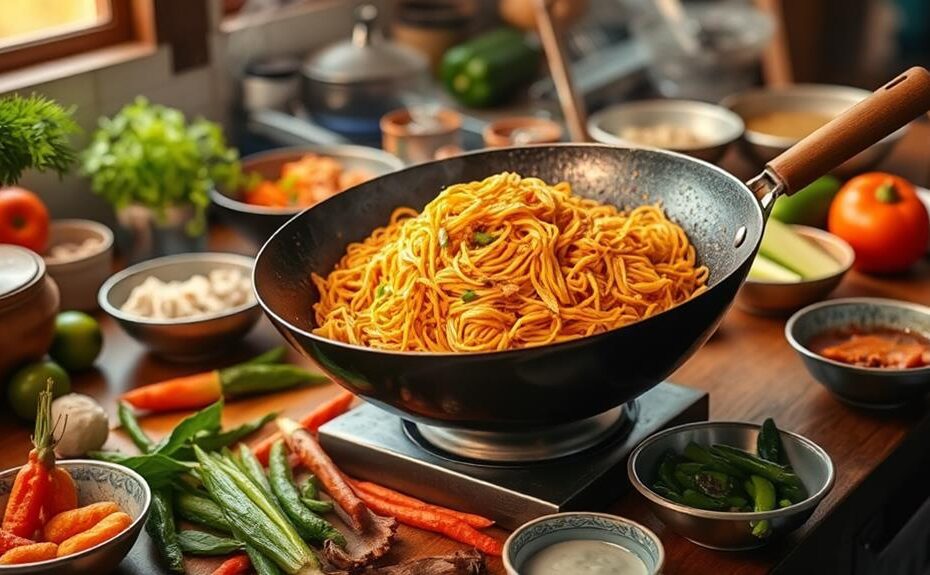Choosing the Right Noodle Type
To cook authentic Filipino pancit, selecting the right noodle type is crucial. Rice vermicelli (pancit bihon) and egg noodles (pancit canton) are the two popular options. The noodle type affects the overall dish texture and flavor.
Rice vermicelli noodles are thin, delicate, and absorb flavors well, while egg noodles are thicker, chewier, and hold their shape.
Preparing Essential Ingredients
Garlic, soy sauce, and chicken broth are essential ingredients in cooking pancit. Mince the garlic to release its flavor and aroma. Use a high-quality soy sauce to add depth and umami flavor.
Chicken broth provides moisture and richness to the dish. Soaking the noodles is also crucial to achieve optimal texture and prevent overcooking.
Mastering Cooking Techniques
Understanding the cooking techniques is vital to achieving the perfect pancit. Stir-frying and sautéing are essential techniques to combine the ingredients and cook the noodles evenly.
Controlling the heat and cooking time ensures the noodles are cooked al dente and the ingredients are well combined.
Cultural Significance of Pancit
Pancit is more than just a dish; it represents long life, prosperity, and unity in Filipino culture. Serving pancit during special occasions and gatherings symbolizes the bonds between family and friends.
By mastering the art of cooking pancit, you'll not only create a delicious meal but also connect with the rich cultural heritage of the Philippines.
Understanding Pancit Fundamentals
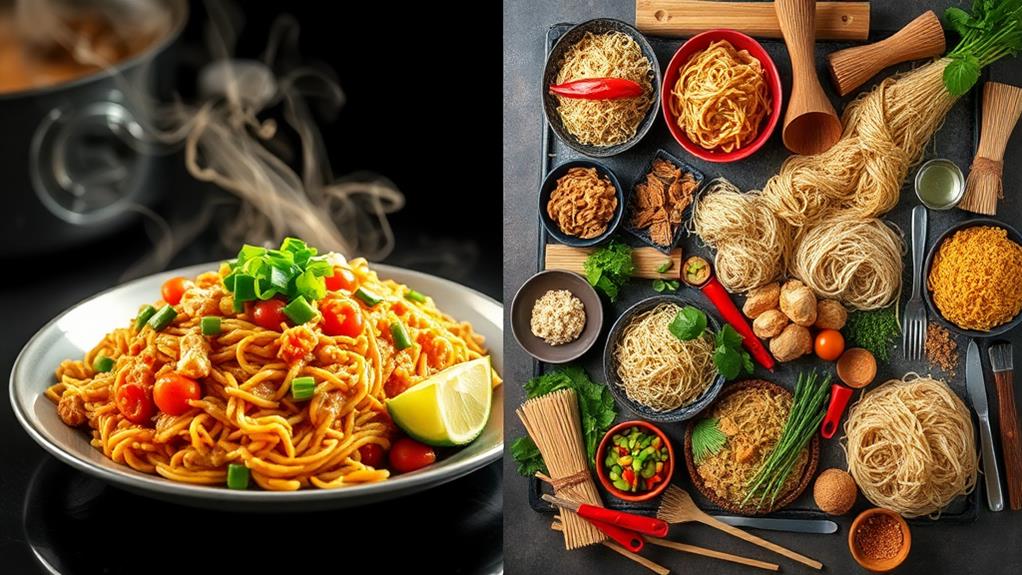
Understanding Pancit Fundamentals
Choosing the Right Noodles
To cook authentic Pancit, you need to select the appropriate type of noodles. Pancit Bihon, made from rice vermicelli, provides a lighter texture, while Pancit Canton, made from egg noodles, offers a chewier bite.
Creating an Authentic Recipe
To develop a genuine Pancit recipe, you must incorporate essential ingredients. Garlic, soy sauce, and chicken broth are key components that combine to create a savory and umami taste experience.
Additionally, include a variety of vegetables, such as cabbage, carrots, and green beans, to add texture and depth to your dish.
Preparation Techniques
To ensure even cooking and prevent blandness, it's crucial to cut your vegetables uniformly and soak your noodles correctly.
Ingredients and Nutrition Breakdown
Pancit Ingredients and Nutrition
A traditional Pancit recipe consists of essential ingredients, including pork, onions, garlic, cabbage, and various vegetables, which provide a range of flavors and textures.
These ingredients contribute to the nutrition breakdown, making Pancit a hearty meal option.
Nutrition Breakdown:
A serving of Pancit contains approximately 605 calories, with 73.5 grams of carbohydrates, 22.8 grams of protein, and 23.6 grams of fat.
Soy sauce and chicken stock add to the savory flavor profile and provide a source of sodium.
Fiber-Rich Vegetables:
The fiber-rich vegetables, such as cabbage and green beans, offer about 4.4 grams of dietary fiber per serving, aiding digestion.
Variations and Adjustments:
Different proteins like shrimp or chicken can be used in Pancit variations, and the nutritional content can be adjusted based on individual ingredient choices and cooking methods.
Cooking Techniques and Methods
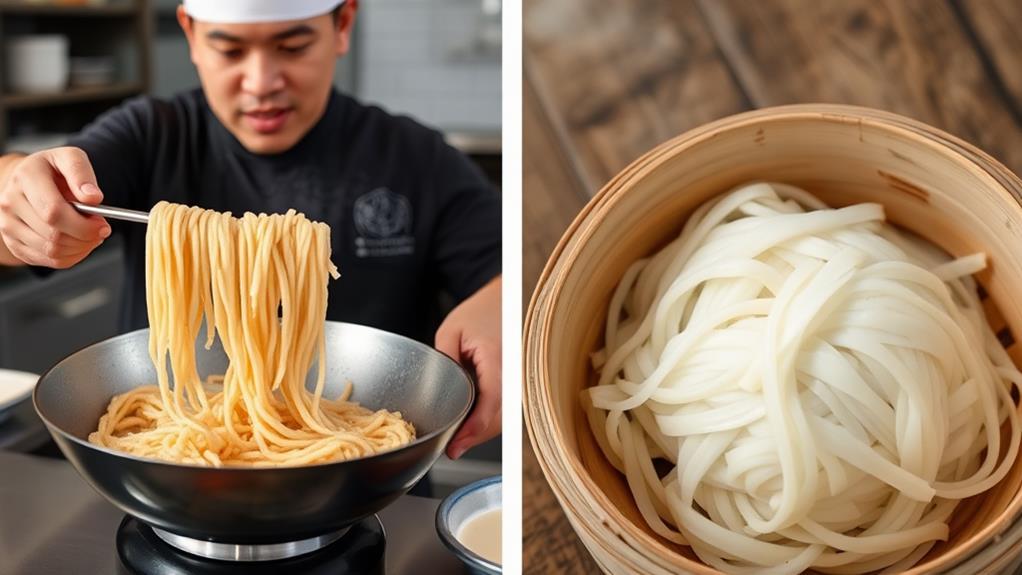
Mastering Pancit Cooking Techniques
To cook Pancit, start by soaking rice vermicelli noodles in warm water until they're softened, allowing them to absorb flavors better during cooking.
Uniform Ingredient Preparation
Cut vegetables and proteins into uniform sizes to ensure even cooking and balanced texture in the final dish.
Stir-Frying with a Large Skillet or Wok
Use a large skillet or wok to prevent overcrowding and ensure uniform cooking. This allows for easy stirring and even distribution of heat.
Protein and Vegetable Cooking
Cook proteins, such as pork or shrimp, thoroughly before adding vegetables to develop a richer flavor base.
Then, add vegetables later to retain their crispness.
Seasoning Adjustment
Adjust seasoning, particularly soy sauce and salt, throughout the cooking process to customize the flavor profile to your taste.
Traditional Serving Suggestions
Traditional Serving Suggestions for Pancit
Pancit is best enjoyed in a traditional setting, surrounded by family and friends. In Filipino culture, Pancit is often served during celebrations and gatherings, symbolizing long life and good fortune.
Creating a Complete Meal
Pair Pancit with lumpia (Filipino spring rolls) to showcase the diversity of Filipino cuisine. Lumpia adds crunch and flavor contrast to the dish.
Adding Flavor and Texture
Serve lemon or calamansi on the side to add a zesty kick that complements the dish. The acidity of lemon or calamansi enhances the flavors of Pancit.
You can also serve sautéed broccoli or other vegetables alongside Pancit for added texture and nutrition. Vegetables provide a nutritious and filling complement to the dish.
Versatility in Serving
Enjoy Pancit as a main dish or as a side dish to grilled meats, enhancing the overall dining experience. Pancit pairs well with grilled meats, such as chicken or pork, for a satisfying meal.
This versatile dish can be tailored to your taste preferences, making it a staple in any Filipino gathering.
User Feedback and Experiences
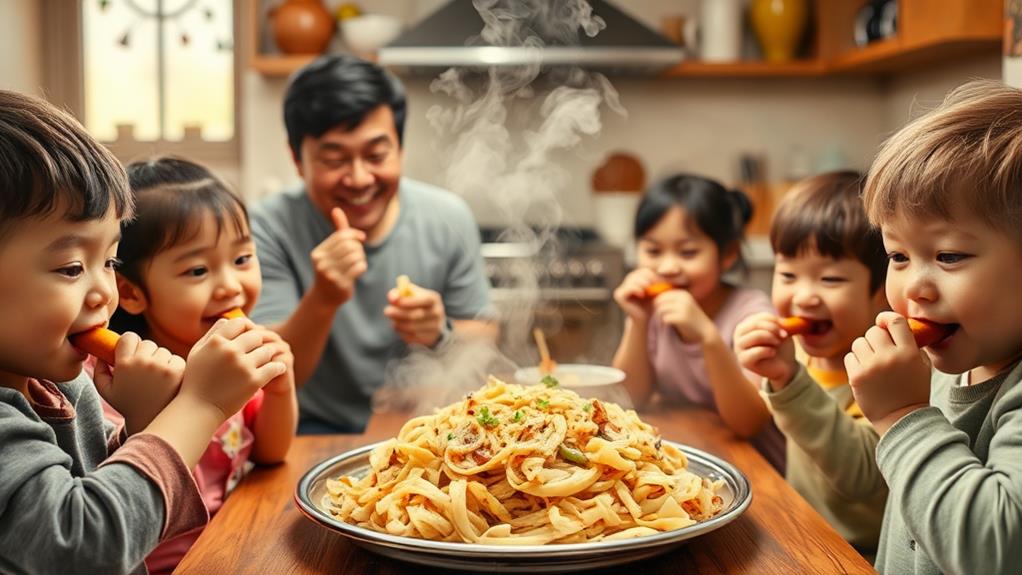
User Experiences with Pancit Cooking
Many users have shared their positive experiences with Pancit recipes, citing the authentic Filipino flavors and nostalgic memories they evoke.
These recipes aren't just comfort food, but a way to connect with one's heritage.
Practical Tips for Cooking Pancit at Home
When cooking Pancit at home, users have shared the following insights:
Adapt recipes to your taste by adjusting the seasoning or adding your favorite vegetables and proteins to make the dish your own.
Enhance flavor depth by adding more robust seasoning or ingredients like oyster sauce to take your Pancit to the next level.
Don't be discouraged by bland flavors; instead, try adjusting your cooking technique or adding more seasoning to prevent excess liquid.
Connecting with Filipino Roots
Through shared recipes and community engagement, users have expressed gratitude for the opportunity to connect with their Filipino roots.
Pancit Bihon Vs Pancit Canton
Pancit Bihon and Pancit Canton: Two Popular Varieties
Two prominent types of Pancit have emerged: Pancit Bihon and Pancit Canton. The primary difference between them lies in their noodles. Pancit Bihon uses rice vermicelli noodles, while Pancit Canton features egg noodles, resulting in distinct textures and flavors.
Cooking Methods Differ
When cooking Pancit Bihon, rice noodles need to be soaked before stir-frying. In contrast, Pancit Canton noodles can be added directly to the dish without soaking.
Textures and Flavors
The difference in noodles translates to a lighter, more delicate texture in Pancit Bihon and a chewier consistency in Pancit Canton, making them suitable for different palates.
Similar Ingredients, Different Profiles
Both dishes often include similar ingredients like chicken, vegetables (such as carrots and cabbage), and sauce and seasoning.
However, the latter may vary based on personal and regional preferences.
Pancit Bihon is often served at celebrations for its lighter profile, while Pancit Canton is favored for its heartier and richer flavor, making it a popular choice for larger gatherings.
Regional Recipe Variations
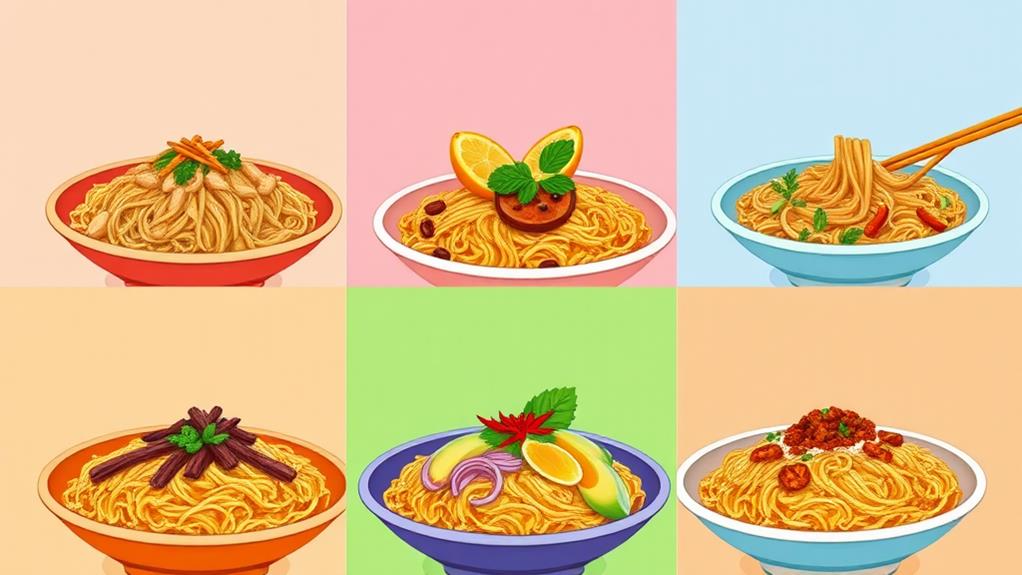
Regional Recipe Variations of Pancit
Pancit's adaptability is evident in its regional recipe variations, which add a rich layer of diversity to this beloved Filipino dish.
Visayas Region: Pancit Bam-i
In the Visayas region, Pancit Bam-i combines both bihon and canton noodles, offering a unique blend of textures and flavors.
This variation is often highlighted by the use of soy sauce and a mixture of seafood and meats.
Metro Manila and Laguna: Pancit Malabon and Pancit Habhab
In the Metro Manila area, Pancit Malabon is known for its thick sauce and seafood toppings.
Meanwhile, in Laguna, Pancit Habhab is served on a banana leaf and typically features a mix of pork and vegetables.
Isabela: Pancit Cabagan
In Isabela, Pancit Cabagan stands out with its distinctively thick sauce made from soy sauce, vinegar, and ground pork, and is often served with hard-boiled eggs on top.
Each regional Pancit recipe reflects local ingredients and culinary traditions, showcasing the adaptability of this beloved dish across different Filipino communities.
Can I Use Your Complete Guide to Cooking Pancit to Make Easy Pancit Dishes as a Beginner?
Yes, you can use the Complete Guide to Cooking Pancit to make easy pancit food dishes as a beginner. The guide provides step-by-step instructions and tips to help you create delicious and authentic pancit dishes with ease. It’s a great resource for anyone looking to master the art of pancit cooking.
Cultural Significance and History
Pancit: A Symbol of Filipino Culture and Tradition
In Filipino gatherings, Pancit is a staple dish that symbolizes long life and prosperity. This traditional noodle dish is more than just a meal; it's a representation of cultural heritage and family bonding.
Pancit's Cultural Significance
Birthdays: Pancit is served to symbolize long life and prosperity.
Weddings: It represents unity and new beginnings.
Family gatherings: Pancit fosters community and bonding.
Filipino heritage: It preserves culinary traditions.
Pancit's Cultural Impact
Pancit's cultural significance extends beyond special occasions.
Recipes are often passed down through family, showcasing the country's diverse regional culinary traditions.
Historical influences from Chinese cuisine introduced noodles to the Filipino diet, leading to the creation of Pancit as a beloved staple.
Whether you're enjoying Pancit Bihon or Pancit Canton, you're experiencing a piece of Filipino culture.
Frequently Asked Questions
How Do You Cook Pancit Canton Steps?
Step 1: Soak the Noodles
Soak the pancit canton noodles in warm water for 5-10 minutes to rehydrate them.
After soaking, drain the noodles and set them aside.
Step 2: Prepare the Aromatics
Heat oil in a large skillet or wok over medium-high heat.
Add minced garlic and diced onions and sauté until fragrant.
Step 3: Add Protein and Vegetables
Add your choice of protein (such as cooked chicken, pork, or shrimp) and cook until browned.
Then, add veggies like carrots and cabbage and cook until they're tender-crisp.
Step 4: Combine Noodles and Seasonings
Combine the noodles with soy sauce and desired seasonings (such as salt, pepper, and patis).
Stir well to combine and heat through.
What Kind of Noodles Are Used in Pancit?
Rice vermicelli noodles, also known as bihon, are traditionally used in pancit. These noodles absorb flavors beautifully during cooking.
Thicker egg noodles, known as pancit canton, are also used, offering a chewier texture. Some recipes combine both types of noodles to achieve varied texture and taste.
In some cases, udon noodles are used as an alternative, providing a heartier bite.
What Is Pancit in English?
Pancit directly translates to "noodle" in English. This popular Filipino dish has a rich history, originating from the Hokkien word "pian e," which means "convenient food."
The term "pancit" refers to a variety of noodle dishes that can feature different noodles, ingredients, and flavors depending on the region.
Despite these variations, pancit's significance remains the same: it's often served during celebrations, symbolizing longevity and prosperity.
What Is the Filipino Tradition of Pancit?
Pancit is a traditional Filipino dish deeply rooted in the country's history and cultural significance.
It is often served during festive occasions like birthdays and family gatherings, symbolizing long life and good fortune.
This tradition is reflected in the various regional variations of pancit, each showcasing local flavors and traditions.
For example, Pancit Bihon and Pancit Canton are two popular variations that highlight the diversity of Filipino cuisine.
This dish is a true reflection of Filipino hospitality and community, bringing people together to share in the joy of celebration and good food.
